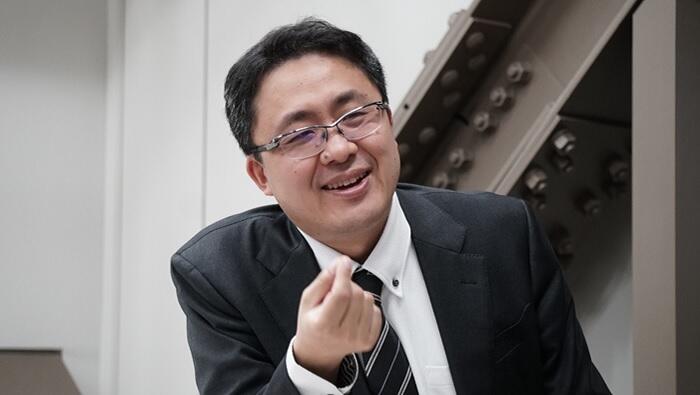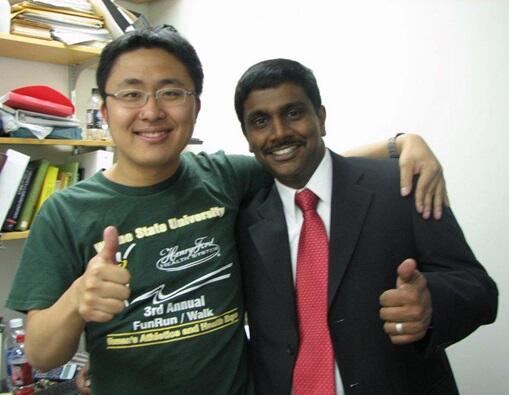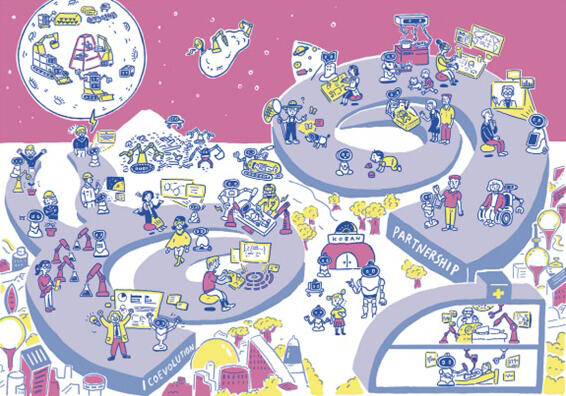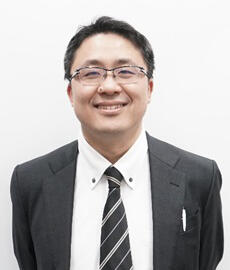When the words AI and robots are mentioned, many things may spring to mind. Sci-Fi tropes such as Skynet from the Terminator series, or Disney Pixar's garbage collecting robot WALL-E are common examples in television and movies, but recent developments such as ChatGPT are more concrete results that have been released in recent years. A major area that these technologies may be adapted into are in the disaster response and space related fields, environments that are extremely challenging and dangerous for humans to maneuver and undertake work in.
Another key area is in the automation of labor, an important goal in countries facing falling birth rates and aging populations. Despite the global population crossing the 8 billion mark in late 2022, many developed countries have birth rates well below replacement levels, with countries such as Korea and Japan being key examples of this. One potential solution to this problem is the development of AI and robots, particularly in fields such as health care, disaster response and transportation. The ambitious Moonshot Research and Development Program is also taking on the challenge of adapting these technologies through its Goal 3: Realization of AI robots that autonomously learn, adapt to their environment, evolve in intelligence and act alongside human beings, by 2050.
In this article we continued our tour of the Moonshot R&D Program and spoke with Project Associate Professor Pang-jo Chun of the Department of Civil Engineering at the University of Tokyo, a Korean national with a background in Japan, the United States and Korea, to hear about his experience with civil engineering and AI and how they are interconnected through Moonshot Goal 3.

A 'regular' path leads to an extraordinary journey around the Pacific
Pang-jo Chun is a Korean national who was born and raised in Japan. He had, in his words, "a regular Japanese path" from his schooling days through to entering the University of Tokyo. He undertook a course in civil engineering, and after learning that the mechanics and mathematics that he was studying in his course were closely tied to the real world, developed a strong passion for the field. He reminisced on his time as a student, saying, "I understood that if I continued my studies, I could have the opportunity to the make public spaces, and potentially the world, better. This is how I developed a strong passion to continue working in the field."
After completing his undergraduate and master's degrees at the University of Tokyo, he advanced on to a PhD in civil engineering. It was at this time that his interest in exploring opportunities overseas pushed him to search for opportunities in the United States. He had heard good things from his colleagues and supervisors, and wanted to explore fresh perspectives, and undertake research in an environment that used different rationales. "I wanted to experience for myself how people in the US see and think about things. I had often heard that US society was built on various rational systems, and so decided to complete my PhD at Wayne State University, in Detroit." Chun stated. "Being exposed to a different culture was undoubtedly a wonderful experience."
Following his graduation, Chun's roots called him home to Korea. He had previously undertaken an exchange at Yonsei University in Seoul, and a supervisor there had there offered him the chance to do further research at the institution. This, combined with the desire to live in the country of his grandparents led him to return. "I observed various things and found that there were customs, cultures, and ways of thinking that differed from both Japan and the United States, which was also a great opportunity. In a society where Confucian and Christian ideas are mixed together, I felt that it is interesting when various cultures and ideas blend, which is something that I also thought during my time in the US."

Provided by Project Associate Professor Chun
After these overseas experiences, Chun returned to Japan, where he took up a position as an Assistant Professor at Ehime University in Shikoku, in a position that engaged in research across industry, government, and academia. After building a network of contacts and seeking challenges beyond what he was undertaking in Ehime, he was offered a position as a Project Associate Professor at the University of Tokyo, where he is still currently undertaking his research activities. While describing the move, Chun highlighted the University as a great place to undertake research, especially the international elements that were highlights of his time abroad. "Moving to the University of Tokyo has once again changed the world around me, and I continue to be inspired. The university has a large number of international students, and increased contact with overseas universities and companies provides an environment that is an incredible place for me to learn and grow."
Shooting for the Moon through the integration of AI and robotics in civil engineering
The Moonshot Research & Development Program covers 9 broad and ambitious goals with a key focus on actively improving society and providing outcomes that benefit mankind. Chun is involved with Goal 3, which as highlighted before, is aiming to realize a society in which AI robots can autonomously learn and live together with humans. One project being undertaken under this umbrella is the "Collaborative AI robots for adaptation of diverse environments and innovation of infrastructure construction," project, headed up by Project Manager (PM) Keiji Nagatani, who serves as a Project Professor at the University of Tokyo. Chun recalled being asked to join the project, "As a researcher actively conducting AI research in the field of civil engineering, I was approached to participate in this project. Additionally, my prior research experience with UAVs and construction machinery played a significant role in being invited."

https://www.youtube.com/watch?v=b6nU7FNkjbo
Chun's interest in AI actually began when he was younger, where he actively tried to apply AI to games that he designed during his time as a high school student. His early adoption of the technology was a key factor to his attempts early in his career to introduce it to his field. This continued through to his current research projects, "I am working on developing AI to be mounted on autonomous unmanned construction machines. Specifically, I am focusing on situations where river channel blockages have occurred due to disasters. The AI will capture images of the surrounding slope collapses and ground conditions, and then use that information to assess whether the location is likely to become dangerous in the future. This will enable the machines to preemptively evacuate or take actions to mitigate the hazards in the area." Further potential uses of the technology may also be applicable in civil engineering projects. The interior of concrete or steel can act as a black box following disasters or long-term use, with the actual status following events such as earthquakes being unknown. AI can potentially provide answers through modelling and prediction that would otherwise be impossible without breaking structures down to directly look inside of them.
Moonshot has a number of lofty and ambitious goals, but when we asked Dr. Chun about what he expects to achieve at the end of the project, he had a number of concrete examples for us. "We can expect to develop robots and AI that will be useful in disaster situations. However, beyond that, I would like to consider the fundamental principles of how we can create AI that truly serves human needs." Beyond disaster scenarios, he also believes that robots will aid in alleviating the issue of labor shortages. However, "There is currently no robot like Doraemon (A famous robot seen in a Japanese cartoon), that can think for himself and do a wide range of tasks, so we need to create AI and robots that can work in an appropriate way." He also touched on the necessity of making a society that allows for the integration of robots and AI, to allow them to collaboratively work not only on a single job, but to complete a wide range of tasks.
As a future technology, AI robots are an exciting prospect with significant potential benefits to society. However, they still have a number of drawbacks to overcome. "I believe that if robots can replace hard or monotonous work, it will provide a significant social benefit. However, as I mentioned earlier, outdoor environments can be quite challenging for robots. There is limited training data that can be used to help with this, but many hard and unpleasant tasks exist outdoors, so we need to develop technologies that can assist humans in such situations. On the other hand, I used to think that the dangerous situations like the ones in Sci-Fi, where robots harm human society, were impossible, but as I observe the development of large language models like ChatGPT, I'm gradually starting to think that we can't predict what might happen in the future. We need to use our minds now to carefully consider frameworks for maintaining control over these technologies." Chun said, sharing his thoughts on the issue.
The research benefits of circling the Pacific
As a Korean national with experience in Japan, the US and Korea, as well as a researcher who speaks 3 languages, he provides a wonderful example of the benefits of research mobility. His time working in each of these countries provided him insights into the benefits or working abroad, as well as the unique points of each region. He cited communication styles as a key difference, saying "In the United States, I learned to communicate what I want others to do in a straightforward manner while still being respectful. I felt that this approach makes technical and research communication extremely smooth. On the other hand, both Korea and Japan have a similar tendency to communicate in a more roundabout way. However, I don't think this is necessarily worse than the American style." A major benefit of this experience was developing the ability to view things from a wide range of perspectives and standpoints.
In bringing these experiences back to Japan, Chun stated that "Contrary to stereotypes, Japanese people are flexible thinkers. They quickly realize that if something needs to be done, it should definitely be done because it is necessary." This flexibility in thinking makes Japan a unique place to do research, and many researchers undertake very unique projects. The outcomes of this can be seen in the number of 'Ig Nobel Prize'*1 recipients that are from the country.
Chun continued by praising the environment's ability to promote diverse research by linking it to his own experiences. "There is a culture that tolerates diverse research. When I started AI research maybe 15 years ago, there were a lot of people who doubted it and said, 'are you sure?' but none of them tried to stop me undertaking it." This allows for researchers to undertake the type of research that they are interested in, while also seeking outcomes that are beneficial to society.
He also downplayed another stereotype associated with Japan, the language barrier. "Japanese people can be shy, and although it can be difficult to communicate without Japanese, there are many cases where grants and other documents can be completed using English. Many institutes also have English support staff and translation software is able to translate things nearly perfectly these days."
"Please come to Japan! Let's work on something together. Right now, Japan is strongly seeking people with new ideas, and it is a country where 'you,' with your fresh perspectives, can thrive and make a difference." He added as a final piece of advice and call to action to those who are interested in Japan as a base for undertaking research.
Looking towards a future with AI robots
We finished the interview by asking about the future prospects of Moonshot Goal 3, as well as Chun's own goals for the future. His first response was to again stress the idea of flexible research, saying, "I will be happy if I can conduct research while maintaining my sense of curiosity. I will be even happier if that research is beneficial to society and makes academic contributions as well."
The very concept of AI and robotics fall under the umbrella of future technology. However, Chun brought up the importance of social sciences when thinking about AI in the future. "Philosophy provides deep insights for contemplating these ethical issues and offering guidance. Existential questions such as how AI will blend into our lives and whether AI can possess self-awareness may also point to future directions for AI research." Language models, such as ChatGPT are already becoming integrated into our society, and Chun raises an important issue as we look towards a future that becomes increasingly integrated with technology. Smart bridges that are connected to the Internet of Things and are able to communicate traffic loads with one another or inform maintenance staff about damaged parts, such as those that bear loads was another concept that he shared.
To conclude Chun expressed his enthusiasm towards the future and possible overseas research, "I wouldn't rule out the possibility of conducting more research overseas. In fact, this is how I have built my career to date and I'm excited to see what the future holds for me!"
As a researcher working on a cutting-edge field, as part of an exciting future oriented project and as a great example of the benefits of international brain circulation, Dr. Pang-jo Chun will continue to work towards a future where AI and robots are integrated into society. The Science Japan team eagerly looks forward to hearing more about his research outcomes in the future and one day experiencing the society that his research aims to realize.

Profile
Chun Pang-Jo
Project Associate Professor, Department of Civil Engineering, the University of Tokyo.
A Korean national, raised in Japan. After completing his undergraduate and master's degrees in civil engineering from the University of Tokyo he undertook a PhD at Wayne State University in Detroit in the United States. Following this he took up a post-doctoral position at Yonsei University in Korea. Since his return to Japan, he has held a position as an Assistant Professor at Ehime University and has been in his current position at the University of Tokyo since 2019. Researcher as part of Moonshot Goal 3.
Moonshot Goal 3: https://www.jst.go.jp/moonshot/en/program/goal3/
Dr. Chun: https://scholar.google.co.jp/citations?user=x7GHBLAAAAAJ&hl=en
*1 Ig Nobel Prize: An informal "prize" that is a light parody of the world-famous Nobel Prize. They honor achievements that make people laugh, then think. The prizes are intended to celebrate the unusual, honor the imaginative — and spur people's interest in science, medicine, and technology: https://improbable.com/ig/about-the-ig-nobel-prizes/




